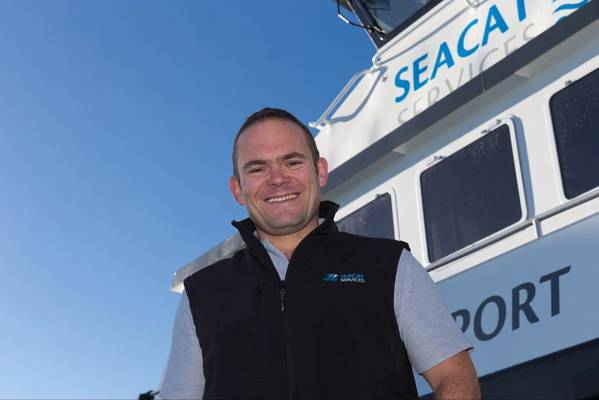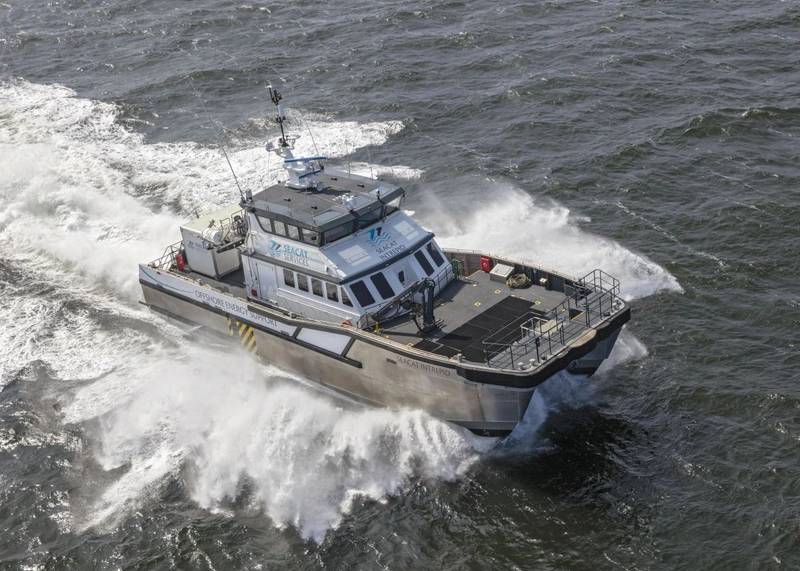
Seacat Services is a UK-company providing support services to the offshore wind industry in the UK and elsewhere in Europe with a fleet of 14 UK-built catamaran vessels.
Over the past eight years, the company has used its fleet of 14 South Catamaran vessels ranging from 21- 27 meters to serve over 30 wind farms, including Beatrice, Triton Knoll, and Sheringham Shoal offshore wind projects.
Seacat Services has 22 shore-based employees and between 70 and 110 seafarers, depending on how many of Seacat's vessels are on 24-hour contracts, Ian Baylis, the company's founder and managing director told Offshore Engineer in an interview.
So, where in a wind farm's life cycle are Seacat's vessels mostly used?
"As all of our vessels are designed to be multi-purpose, our fleet is very versatile, with each vessel swift enough for high-speed crew transfer and large enough for supply charters," Baylis says.
However, Baylis says the company provides services other than just crew transfers: "Our capabilities enable us to provide multiple services to the offshore wind sector from the construction phase onwards - including the operation and maintenance of offshore wind turbines which make up the majority of activity over an offshore wind farm’s lifespan."

Caption: 26m Seacat Intrepid vessel
COVID-19 impact
As everybody is well aware by now, no conversation about business can be had without talking about COVID-19. So, how has the whole situation affected Seacat? What does it entail onshore, how does one keep one's distance offshore?
Baylis says: "We have had to adapt a number of our working practices both onboard and onshore as a result of Covid-19. In regard to our team based onshore, we are continuing to adhere to government guidelines and the office is being run by a skeleton crew."
This means that onshore, one person is operating the company's manual business activities downstairs and one manager is upstairs to support for health and safety reasons.
"Our engineering team has made a rapid adjustment to remote working which is also proving effective," Baylis says.
When it comes to the offshore part of the business - crew changes - the Seacat Services managing director says the company has had to be innovative.
"Crew changes have required us to be innovative and we are avoiding major transportation hubs such as ports, airports and train stations. Instead, crew changes are now happening through one-way hire cars. These are delivered to crew members’ houses, cleaned and then driven to the vessels where the driver then cleans the car again before disembarking - allowing the crew member returning to shore to drive it home.
To date (info as of May 2020), we haven’t seen any cases of Covid-19 on our vessels or from any of our shore-based employees. We are ensuring that business can continue as usual as far as possible and our overall operations - and those of the industry more broadly - remain robust.
Social distancing?
COVID-19 measures worldwide have called for people to wear masks, and keep a distance from each other. How does one ensure social distancing while on a Seacat vessel?
"Typically, crews live and work together in relatively confined spaces for extended periods. To mitigate the transmission of Covid-19, crews have been grouped into ‘households’, where they work in fixed teams onboard vessels and stay in the same accommodation when onshore," Baylis explains.
But this is not all, to maintain social distancing measures between passengers and crew the company has introduced several other measures.
These include reducing the number of passengers onboard vessels during operation; separating the crew and passengers in different areas of the vessel, with the crew stationed in the wheelhouse and using the back door, and passengers positioned in the galley and using the front door. Each group has separate facilities.
Further, the company is providing high-quality personal protective equipment, safety briefings are now given over the tannoy rather than in-person.
Also, Baylis says that the company makes sure that stringent deep cleaning takes place every day on the vessels, and Seacat's customers screen all passengers prior to coming on board.
"We also have emergency response plans in place. If there was to be a suspected case of Covid-19 we have a dedicated isolation area prepared, typically a cabin, then after transportation a professional cleaning contractor is hired to thoroughly clean the vessel," Baylis says.
Cross-chartering
While Baylis has explained that crews have been grouped into ‘households,' there are still cases where fewer people go aboard to maintain the distance. Does this mean there needs to be more vessels in operation to compensate? If so, who foots the bill?
"We have seen enquiries from customers for additional vessels for short-term operations and in those cases the customer naturally takes responsibility for the bill - but the industry has largely been able to avoid this by cross-chartering. Collaboration amongst operators can compensate for missing vessels - which has significantly helped minimize the impact of the coronavirus on the industry," he says.
With the social distancing difficulties seemingly resolved by grouping crews into 'households' and cross-chartering, this doesn't mean there are no more challenges in the offshore wind space related to COVID-19. Some projects have been delayed.
The Seacat Services boss says that a number of summer operations and maintenance campaigns which were supposed to start in April and run to October have been postponed until August due to the coronavirus which is pushing the work back to the autumn and winter.
"As a result, our end of the market is now seeing enquiries as larger vessels can operate more effectively in rougher weather and therefore have longer ‘time on turbine access," Baylis says.
According to Baylis, offshore wind project owners and operators are currently sweeping the market to ascertain the availability of these vessels, but a lot of the larger vessels are now out on long-term contracts. It’s possible that a number of these campaigns will be cancelled but I think the majority will still go ahead.
Busier than expected
Offshore Engineer asked the Seacat Services Managing Director to go back to January 1, 2020, and share with us his then expected outlook for Seacat for the year. Considering the seemingly neverending cycle of depressing news these days, Baylis' answer might surprise you.
"At the start of January, we expected 2020 to be a year of high occupancy for our fleet but we didn’t expect to be operating consistently at close to full capacity. We are therefore busier than expected which is good news overall and should help build confidence from our financiers and shareholders following some turbulent years in the market, providing that the cost base remains the same," he says.
Seacat Services has made a name for itself in the North Sea's offshore wind sector. The UK, especially, is one of the most developed areas in the world when it comes to offshore wind, but, according to available info, more than 5,000 operational offshore turbines are still expected in the UK by 2025. Will this call for a fleet expansion?
"Currently the market is being consolidated into three or four big conglomerates which are acquiring larger fleets, and there is also a fair amount of rationalization occurring in the sector. Smaller CTV fleets are being sold off, repurposed, and sent to other markets or industries globally which has resulted in a net loss of crew transfer vessels in the Northern European fleet compared to 2016.
"We are comfortable with the size of Seacat’s fleet as it enables us to manage operations effectively and continue providing high-quality service for our customers, but there may be a need for operators to expand their fleets as they establish themselves in other regions."
Talking about other regions, are there any plans to offer Seacat's services internationally? Taiwan's offshore wind market, for example, is growing.
Baylis says: "We are already active in the European market in countries like Germany and the Netherlands and we often look at how we can offer support to other growing European markets such as France. Although we have no current plans to develop a ‘Seacat Services Asia fleet’ we are continuing to collaborate with our peers in the industry from around the globe, including in Taiwan."
Remarkable adaptability and resilience, and more jobs to come
In conclusion, Offshore Engineer asked Ian Baylis to give his take on the crew transfer vessel sector's presence, in the wake of COVID-19, as well as on the future.
He said: "Despite the coronavirus dramatically changing the way in which the offshore wind market operates, the CTV sector has shown remarkable adaptability and resilience to Covid-19 compared to other industries and has successfully navigated the challenges caused by the virus to allow business to continue as normal as far as possible.
"By collaborating with other operators, customers, and other players in the sector, we have successfully mitigated both the impact and transmission of Covid-19 and have continued to support the development and maintenance of the offshore wind industry to keep the lights on in British and European homes.
"The workboat market has proved itself to be a robust area for employment during the coronavirus crisis and as the market grows the industry is going to need more personnel. Seacat has run numerous apprenticeship schemes in the past which have proved very successful, with people who have never been to sea before becoming vessel masters. The CTV market’s demonstrable resilience during this time may encourage the next generation to pursue a career in the industry," Baylis said.
Join World Energy Report's Offshore Wind Webinar on June 17, 2020. Register here.